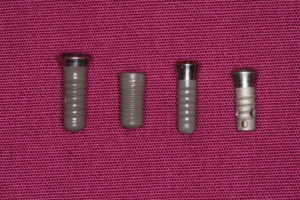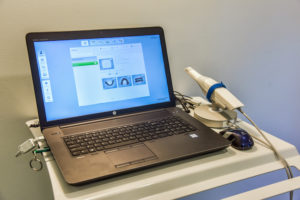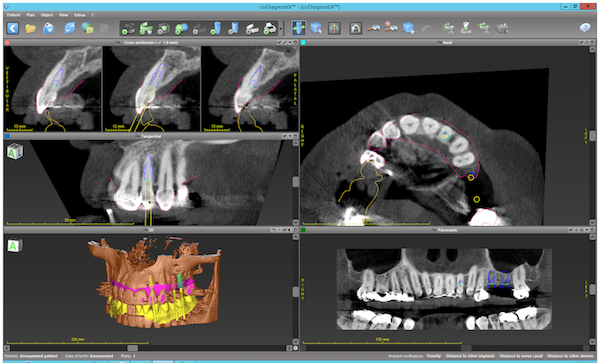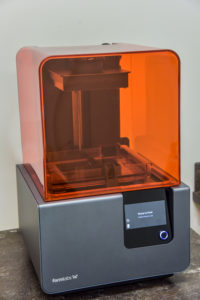The portion of the tooth which you see and use is called the crown. It is supported by the root of the tooth, which is anchored in the jawbone. If we can’t keep the natural root, it is often replaced with a titanium root called a dental implant. The jawbone fuses to the titanium.
The implant ends at or slightly below the gum line. The crowns are then connected to the titanium implants. Often a single crown is attached to one implant. Sometimes a single implant is used to stabilize more than one crown.
Who does what?
Dental implants require a broad range of skills ranging from extraction to bone surgery to crown shapes and colors. It is difficult for any one practitioner to have this wide range of skills.
Dr. Gager does the surgical work including planning, extraction and implant placement. The actual crown replacement is often done by general dentists or specialists in prosthetics.
 What brand of implant does Maine Periodontics use?
What brand of implant does Maine Periodontics use?
Dr. Gager trained initially with Nobel Biocare but has been using exclusively Straumann implants since 1992. He was the first practitioner in Southern Maine to use this brand. Currently, Straumann is the market’s implant leader in the world.
Planning and Digital Dentistry
Planning is the most important first step. Prior to beginning treatment, Dr. Gager needs to do a careful examination. Dr. Gager’s twenty-four years of experience with dental implants is invaluable.
 In addition to over 24 years experience, Maine Periodontics is uniquely well qualified to do complete digital planning.
In addition to over 24 years experience, Maine Periodontics is uniquely well qualified to do complete digital planning.
In the Portland office, our medical grade CT scanner is a Carestream Model 9300. It has multiple options for scan dimensions which allows us to keep the x-ray dose as low as reasonable. The result is a three-dimensional picture of the teeth, bone, and soft tissue.
In addition we utilize a 3Shape brand “Trios” surface scanner. This takes an image of the surface of the teeth, soft tissue, or implants without x-rays.
 The images from the CT scan and Trios scanner can be merged in special software to develop a precise plan for placement of implants based on where the bone is and where the teeth need to be.
The images from the CT scan and Trios scanner can be merged in special software to develop a precise plan for placement of implants based on where the bone is and where the teeth need to be.
The plan is then validated by using a multiple axis device to do the surgery virtually on your models. The final step is to send the images to a stereo -lithographic three-dimensional printer which fabricates exact surgical guides.
What does digital planning mean to you?
 Currently, full digital planning is only done in approximately 10% of implant cases nationally. We do 90% of all surgery with full digital evaluation.
Currently, full digital planning is only done in approximately 10% of implant cases nationally. We do 90% of all surgery with full digital evaluation.
Why? Maine Periodontics is one of the very few offices in the country where this is all done in the office with the doctor doing all the planning as well as the surgery. This assures continuity, reduces cost, and increases accuracy.
What this means to you, the patient, is better, more accurate treatment; less pain; and fewer complications.
Process
Tooth Removal
The actual implant process begins with removal of the tooth. Often bone repair materials are placed when the tooth is taken out so that replacement is easy. You may see this referred to as “socket preservation”.
If the tooth being lost is in the front where it shows, usually a temporary replacement is made before the tooth is taken out. In that manner, you come into the office with a tooth and leave with a temporary tooth. Usually your general dentist makes the temporary replacement and has it sent to Dr. Gager.
Healing
After tooth removal, varying amounts of time are allowed for the bone to heal. The most common time is about 4 to 5 months.
Immediate Implants
We have the capacity to do immediate implants. However, we only do them where there is a substantial benefit to you. This is commonly the case in the upper front teeth where we strive to maintain the shape of the gum tissue for aesthetic reasons. On occasion, we will do immediate implants in the posterior regions where there is a significant benefit.
Bone Evaluation
If the digital planning indicates there is inadequate bone, we use various techniques to grow bone back. These procedures are specific to your individual situation. Dr. Gager has been doing sinus grafting and lateral augmentation for over 15 years.
Implant surgery
Implant placement surgery is usually a shorter and much easier experience for you than an extraction, as a result of digital planning and decades of experience.
Follow-Up
Teeth
Once an implant has been placed it usually takes six to twelve weeks for the bone to fuse to the implant. Your restorative dentist can then begin to make the replacement crown.
Problems
Failures and complications can happen with any treatment in the human body. However, our success rate in initially placing dental implants is approximately 98%. Twenty years after placement, literature studies indicate that approximately 88% of implants are still functioning. We have every reason to keep believing that our experience is the same.
Ailing Implants
Patients are referred in by other practitioners or may come to us directly. Our skill in treating periodontitis and placing implants puts us in a good position to repair implants, if possible.
